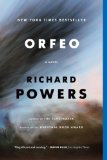Creating Music from Science
This article relates to Orfeo

In Orfeo, the protagonist Peter Els sees many similarities between gene structures and music. "Genomics was right now learning how to read scores indescribably beautiful," Powers writes. And while the book talks about an entire segment of study that is called "biocomposing" with its own dedicated journal and conference, research reveals the projects to be still scattered and not quite corralled into a sturdy discipline.


Since the essence of music can be boiled down to a series of notes, it makes sense that most patterns observed in the universe could be "set" to music. Here are some examples of music derived from science:
- The human genome is a pattern of essentially four bases: A (Adenine); T (Thymine); C (Cytosine) and G (Guanine). So every person's DNA can be set to music with each A or C etc. corresponding to a specific note or pitch. Just as a Bach composition is a set of instructions for various musical instruments to chime in at specific times and with specific notes, so too is the gene expression of one person a set of instructions for different amino acids to show up in a certain frequency. This YouTube video shows how such a musical composition might sound. The concept of setting a gene sequence to music with notes and rhythms is not unique to any one artist and has been repeated many times over the years. As long as the basic elements of music composition are followed, different songs can be composed with the same codes. A company called Your DNA Song takes DNA samples and converts them into specific and unique compositions.
- The regular rhythm of brain waves with their fixed periods translated to music can sound like a calming tune. Now imagine someone having an epileptic brain seizure. How does the electrical activity created by such an incident sound? At Stanford University, Dr. Josef Parvizi and music composer Chris Chafe, have done precisely that. By converting the brain's electrical signals to audio files, seizure activity can be readily detected. Traditionally an electroencephalogram, the reading of which requires extensive training, has been the only machine able to detect seizures. The audio sounds of a seizure, on the other hand, are readily detected and make it easy for even a parent to do so. This knowledge is used to create a sort of stethoscope for the brain, which allows the layperson to use the machine and catch problems.
- NASA gathered radio waves from the far reaches of space gathered by a variety of spacecraft to commission a musical work by the Kronos quartet. NPR hosts samples of these recordings on its website.
- Seismic waves from the earth's crust can also be converted into music patterns as this sample shows.
 Can you think of any scientific phenomena that can be translated into music? The beating of a hummingbird's wings maybe, or even a child's heartbeat in a mother's womb?
Can you think of any scientific phenomena that can be translated into music? The beating of a hummingbird's wings maybe, or even a child's heartbeat in a mother's womb?
first and second images taken from Nathalie Miebach's website. Nathalie is visual artist who works at the intersections of visual art, science and music. In recent projects she has been "translating weather data collected in cities into musical scores, which are then translated into sculptures as well as being a source for collaboration with musicians."
third image of hummingbird from Wikipedia
Filed under Music and the Arts
 This "beyond the book article" relates to Orfeo. It originally ran in January 2014 and has been updated for the
September 2014 paperback edition.
Go to magazine.
This "beyond the book article" relates to Orfeo. It originally ran in January 2014 and has been updated for the
September 2014 paperback edition.
Go to magazine.
Membership Advantages
- Reviews
- "Beyond the Book" articles
- Free books to read and review (US only)
- Find books by time period, setting & theme
- Read-alike suggestions by book and author
- Book club discussions
- and much more!
-
Just $60 for 12 months or
$20 for 3 months.
- More about membership!



 Can you think of any scientific phenomena that can be translated into music? The beating of a hummingbird's wings maybe, or even a child's heartbeat in a mother's womb?
Can you think of any scientific phenomena that can be translated into music? The beating of a hummingbird's wings maybe, or even a child's heartbeat in a mother's womb?
![]() This "beyond the book article" relates to Orfeo. It originally ran in January 2014 and has been updated for the
September 2014 paperback edition.
Go to magazine.
This "beyond the book article" relates to Orfeo. It originally ran in January 2014 and has been updated for the
September 2014 paperback edition.
Go to magazine.